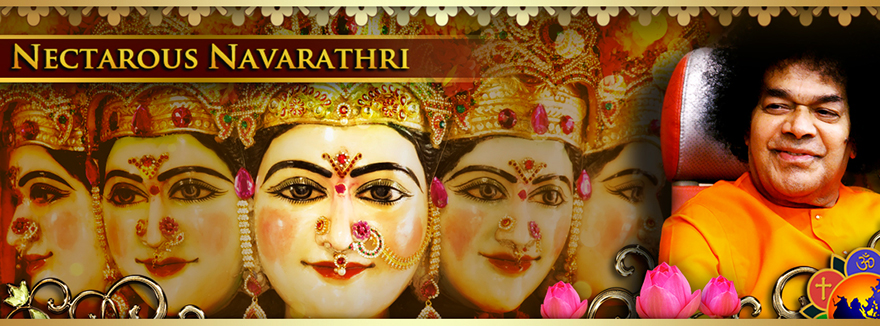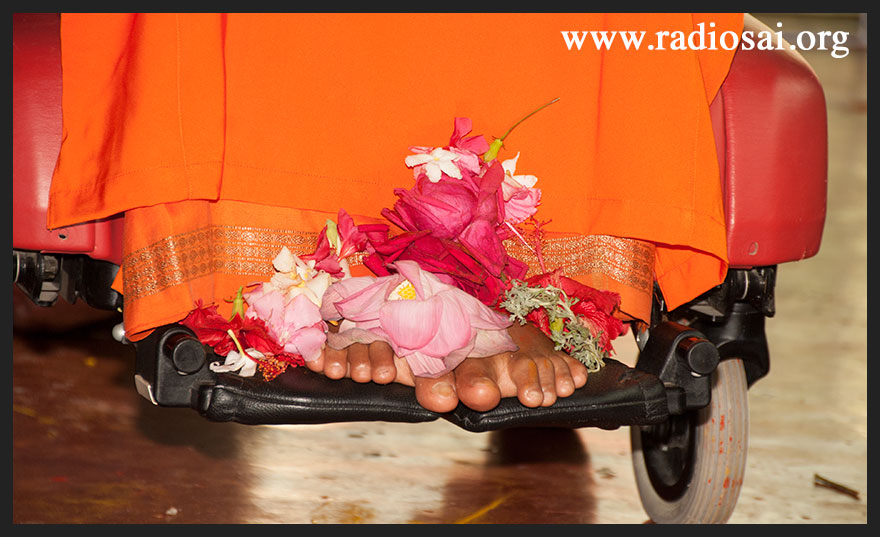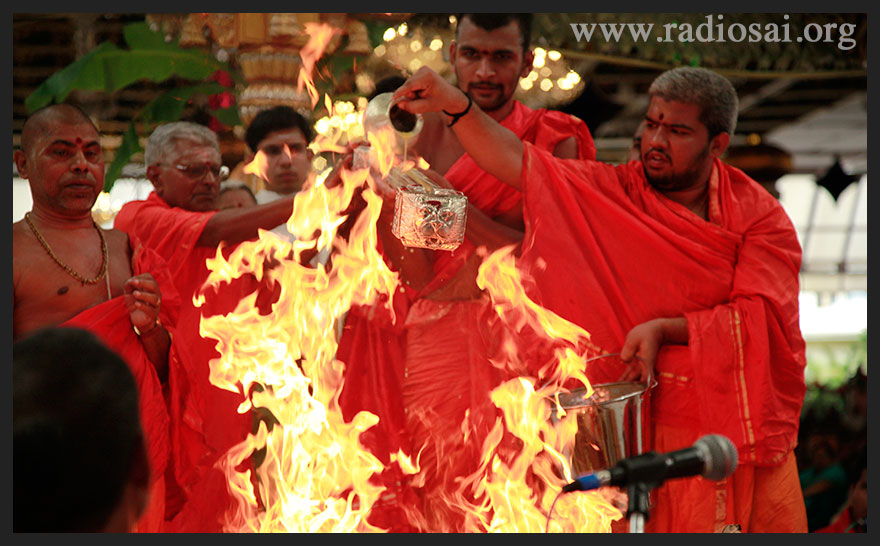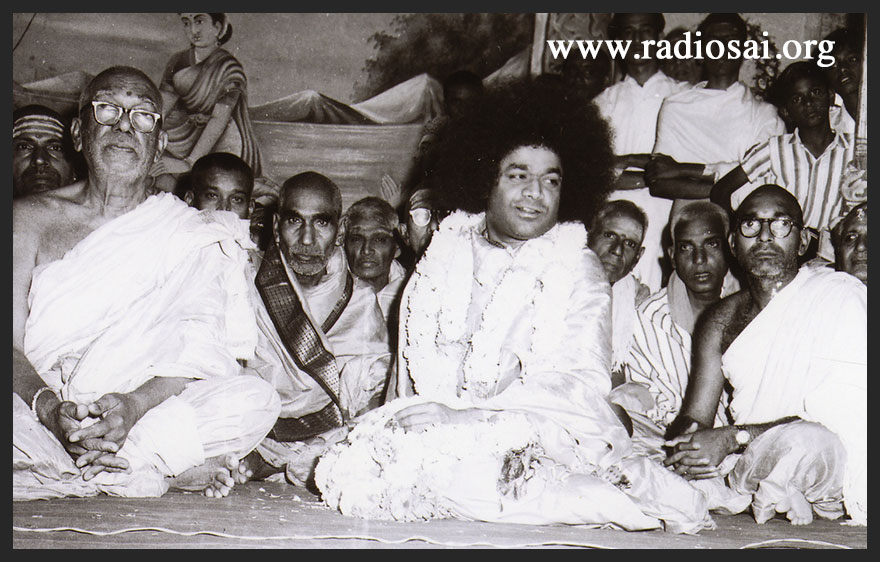|
|
| 'Like' us on Facebook | Follow us: |
Posted on: Sept 26, 2014
THE LIGHT AND DELIGHT OF DASARA
Part-1
 |
Every year the Veda Purusha Saptaha Gnana Yagnam commences in the Poornachandra Auditorium when the priests rub the sacred strands of wood to invoke the god of fire to begin this annual Vedic sacrifice. The whole ambience then reverberates with the chants of these holy hymns.
On the centre of the stage is the exquisite Dasavatara form of the Lord — the Cosmic Consciousness with His varied forms. On the right is the majestic silver chair inviting this Cosmic Consciousness encapsulated in the beautiful, diminutive and delightful form of Sri Sathya Sai to preside over the celebration.
When one sees the resplendent Yagnam in the Poornachandra auditorium, one cannot but recall the declaration Bhagawan made way back in 1962. In fact in October 1962 Swami announced that He was going to start a Veda Pathashala in Prashanthi in a month and when the inauguration did happen in November, Swami revealed:
“My Prema (love) towards the Veda is equalled only by My prema towards humanity. My mission, remember, is four fold: Veda Poshana, Vidwath Poshana, Dharma Rakshana and Bhaktha Rakshana. Spreading My grace and My power along these four directions, I establish Myself in the centre.”
The first, Veda Poshana is the fostering of the timeless values of the ancient culture, all of which have been dutifully documented and powerfully preserved in the Vedas.
Second is Vidwath Poshana, that is, providing sustenance to those engaged in the regular study and steady dissemination of these potent Vedic principles and practices.
Third is Dharma Rakshana which refers to restoration and revival of righteous principles which hold society together and give meaning and direction to every being's existence on the planet.
Fourth is Bhaktha Rakshana or protection of those who have surrendered at least in some measure their time and energy, interests and aspirations, desires and anxieties, goals and missions, restless minds and troubled hearts, youth and vigour, resources and results to God and to the Godward path. Bhagawan said that ensuring the safety, the joy and the happiness of these people is among His most important tasks.
Whenever the flames go up in the air in the Poornachandra Auditorium purifying the ambience there and at the same time sanctifying our thoughts and inner feelings, one's mind always goes back to this pronouncement of Bhagawan.
When we hear, read about and witness the constant chaos that mankind is enmeshed in right now in so many spheres of human development, one only gets increasingly convinced that it is these invaluable virtues enshrined in the Vedas which can rescue modern man. And once we reconnect with our roots and know how to strengthen them, then we know the shoots, branches, flowers and fruits will automatically be taken care of; they will ceaselessly, effortlessly and beautifully blossom.
Dasara is a time to dwell on these sacred ideas and ideals. To help us ruminate on these lines a few former students of Baba's university engaged in a discussion on Radio Sai in October 2012. This was part of the Thursday Live segment “Outside Inside Deep Inside” hosted by Radio Sai's Bishu Prusty. We present below edited excerpts of that session which had three participants:
1. Mr. K. Veda Narayanan, Sanskrit teacher in Sri Sathya Sai Higher Secondary School since early 1980s.
2. Mr. N. Siva Kumar, Faculty member in the Department of Management and Commerce, Brindavan Campus, Sri Sathya Sai Institute of Higher Learning.
3. Mr. Shashank Shah, who was in 2012, a post-doctoral fellow in the Department of Management Studies in Sri Sathya Sai Institute of Higher Learning.
Bishu Prusty (BP): The festival of Dasara has been celebrated in Prasanthi since the forties and fifties. And over the years it has only increased in its grandeur and beauty. Now in 2012 even though we did not have the beautiful physical form of Swami presiding over the function, the ritual and the festival went on in the same matchless manner. Veda Narayanan Sir, may I ask you, how was it for you sitting in the Poorna Chandra Auditorium this morning?
Mr. Veda Narayanan (VN): It brought a lot of mixed feelings in me because after joining Swami's college, this is the 36th Dasara I am attending. I was comparing one of those days with this morning's procedure (October 2012). We used to get up with such enthusiasm and get ready with such anticipation especially during Dasara because this is something special for Vedam boys. The Dasara celebration is totally dedicated for Vedic learning.
 |
Those days I used to get up at 2 a.m. with a lot of anticipation and I did the same this morning too. However, we miss the physical presence of Bhagawan. I remember going and sitting inside the prayer hall in the early morning and waiting for the Lord. The pundits who used to come to Swami in those days always used to chant in a particular style of chanting Vedam called krama. They used to circumambulate the whole Mandir and then come and sit. The Lord used to wait for them patiently and when they came to Him, He used to personally distribute orange dhotis and white angavastrams (upper garment) called ‘deeksha vastras’ to each of them.
He used to wait for them to complete their sankalpa. They used to go and change their clothes and come, and then the procession would start. Naadaswaram used to be there and Swami's pet elephant Sai Geetha used to lead the procession. All the students would also be there. There was not an inch of place left in Prashanti Nilayam. There was no Sai Kulwant Hall those days but every inch of the sand was occupied by people. Prashanti was overflowing.
Swami used to come very majestically in the procession and then get onto the stage. He used to beautifully move from one end of the stage to the other. In those days Swami used to chew paan leaves and He had a beautiful smile on His red lips. He used to glide and our hearts used to throb every second when He passed in front of us. I was missing all those days.
BP: So it was happy feeling but at the same time sad and nostalgic.
Siva Kumar Sir, how was it for you?
Dr. Siva Kumar (SK): As Veda Narayanan Sir said we did miss the physical form of Swami. But one thing I was constantly reminded of was that every single offering that was being done in the yagnam was finally reaching Swami. In fact this was one of the very beautiful analogies that Swami gave in the very first yagnam in 1961 during His discourse.
Swami told that that many critics without understanding the significance of yagnam keep saying that people pour ghee and other offerings into the yagnam and say that it's a waste. But they don't understand the inner significance that all this is being done with a great purpose and that all of them ultimately reach the Yagna Purusha (The Main Deity of the sacrifice).
 |
 |
 |
 |
 |
 |
Swami gave a very beautiful analogy, a common example we all understand - a money order. He said that if you want to send money to a person in your village you just go and give the money in the post office along with the address. The money reaches the person in his place but you don't bother about how the money goes in between to reach that person. It's the same way with each of these mantrams being chanted. Each mantram is like an address to a particular devata or the Yagna Purusha. When you chant ‘Swaha’ and you put the offering into the yagnam, it will surely reach that particular Devata (deity) and the Yagna Purusha. You don't need to know how it will reach, just the way you don't enquire how the money reaches the person.
BP: Yes. Fire is the carrier.
SK: Yes. Even though Swami's physical presence was not there we all had the feeling that every single offering being made was ultimately reaching Bhagawan and that we were all being blessed profusely.
BP: That's so beautiful because when the yagna started in the early days, in the '60s itself, Bhagawan made the inner significance of this festival very clear. We also know that when youngsters complain that it's a total waste offering all this ghee, He shares that it is something like agriculture. You remember this Shashank?
Dr. Shashank Shah (SS): Yes. Swami says that criticising the fact that ghee is being offered in the fire is like ridiculing the fact that a farmer is wasting seeds by putting them in his fertile land. When he sows the seeds in his land he is going to later on reap manifold harvest. Similarly when you chant these mantras and put offerings into the yagna kundam you are actually going to benefit manifold.
But then Swami made one thing very clear: He said elsewhere yagnam is done with some tinge of selfishness like praying to Nature for rain or removing the drought and famine conditions, reducing floods, or removing some doshas of the navagrahas (evil effects of planets) etc., but in Prashanti Nilayam the yagnam is done with the single objective of Loka Kalyana or welfare of all. So by these offerings into the yagna kundam you are praying for the welfare of all mankind. As Swami says, this is the real ‘Saashwatha Saukhyam’ or the true happiness which this yagna aims at.
To add a little humour to that, in the discourse which Siva Kumar Sir mentioned Bhagawan said that people are criticising that so much of ghee is wasted during the yagnam but they don't think of how much ghee they themselves have consumed in their own lifetimes and if all that has been of any major benefit to mankind. He added that such a yagnam will confer million-fold more benefit to society.
 |
BP: Yes. Just because we cannot see it, we cannot discount it. We just do not know the science, just like a tribal who doesn't know the science of how a TV works will think that a television is a miracle. I think it's the same here. We do not know the science but Bhagawan is telling us there is a beautiful science to it and we have to accept that.
SK: In fact in one of His discourses Swami did mention that when the yagnam is done with total selflessness and total purity it will surely get reflected, and there is a natural sign for that, which is rain.
BP: And rain is a phenomenon we saw in Prashanti during every Dasara!
SS: Not only that. I remember during the Sahasra Poorna Chandra Darshana Yagnam (83rd Birthday celebrations) there was a three-day programme. After the first day's programme the next morning it rained heavily for 3-4 hours. The proceedings of the yagnam itself were disrupted because the entire Hill View Stadium was drenched.
VN: Swami also mentioned another inner significance of these yagnas. Our thoughts mainly come from the food we consume. Swami beautifully related that whenever we make an offering with mantras into the sacred fire, the smoke that arises out of this forms the clouds which in turn bring rain. This water is so sacred that plants absorb it and produce pure grains, and when we consume these pure grains we get pure thoughts.
BP: It's a cosmic cycle so that everything gets purified. Now owing to modern technology and pesticides everything gets totally polluted.
SK: Correct. In fact the whole process of yagnam apart from being intensely spiritual is also highly scientific, it enriches the entire cosmic cycle.
BP: Wow! I think we will need a separate discussion only on that but let's now proceed to something else. Shashank, you are someone who has read a lot of Sai literature by virtue of working in the publications department of the hostel. From what you have read, can you please share with us about how Dasara used to be celebrated in the very early years, that is, in the bygone era of forties and fifties?
SS: Sure. From what I have come across the earliest account of the Navaratri celebrations is in the period of 1945 - 46. That was the time when the Paatha Mandiram (old mandir) was just constructed and Dasara celebrations were started in a structured way, if I can use that phrase. Devotees used to come from different parts of the country, most of them from South India — Bangalore, Chennai and nearby towns like Kuppam, Vijayawada and other areas. Lots of devotees used to come with their families.
The programme used to be something like this. The authors have described it quite vividly. They had the opportunity of sleeping outside the Paatha Mandiram. So in the morning Swami used to get up when they sang the Suprabhatam. Thereafter Swami used to get ready and come back, and then they used to sing and welcome Him into the puja room where they would do the morning Kumkum Abhishekham (worship with vermillion).
 |
This is how they used to do this: All the ladies used to sit in orderly lines and each of them used to be given a small vessel and a small photograph of Swami. Just like we have bells in our hostel, a bell was rung and when the third bell was given the Omkaram would start. After three Omkarams they would have a Lalitha Ashtothra Namasmaranam or the 108 names of the Mother Goddess.
As we do even now they used to offer Kumkum to the photograph of Swami in their vessel and with the completion of the 108 names the Kumkum Archana would be over. All this while, Swami would be sitting on a chair right in front of them smiling, enjoying and accepting all their offerings in the form of the 108 names of the mother goddess.
After this bhajans on Devi used to start and Swami used to get up from His chair. He would go to each of the ladies who had done the Kumkum Archana and give them Padanamaskar. While this blessing was going on, bhajans used to be sung fervently and joyously by all of them as a group.
After that they had lunch together with Swami and subsequently there used to be an interactive session where Swami used to talk about the scriptures such as Ramayana, Mahabharata, or Bhagavatham and narrate simple stories relating to the great heroes and heroines of the yesteryears. He would take up a humorous incident in the scriptures and then elaborate it in great detail or give the inner significance of some puranic story.
- Radio Sai Team
What do you think about this article? Please let us know by writing in to h2h@radiosai.org. Do not forget to mention your name and country.










